Abstract
In constructing high-geo-stress soft rock tunnels, the major deformation disaster of the surrounding rock has always been the main problem faced during construction. The research on the deformation and loose zone characteristics of large deformation tunnels has positive significance for the safe and rapid construction of tunnels. Therefore, based on the Yuntunpu large deformation tunnel, this article first analyzes the geological and deformation characteristics of the tunnel site area in response to the problem of high-geo-stress soft rock large deformation. Subsequently, on-site testing and analysis were conducted on the loose zone characteristics of four tunnel sections. Finally, based on the comprehensive analysis of tunnel deformation and loose zone characteristics, the causes of large deformation in the tunnel are analyzed. The results indicate that the large deformation characteristics of the Yuntunpu Tunnel are mainly manifested as a large initial deformation rate of the surrounding rock, a short self-stabilization time of the surrounding rock, a large cumulative deformation amount, and a long deformation duration. The Yuntunpu Tunnel is influenced by the grade and structure of the surrounding rock, with a loosening zone ranging from 12 to 14 m, and the wave velocity variation characteristics exhibited by different grades of surrounding rock vary greatly. Adopting collaborative active control of long and short anchor rods is recommended to limit the continued development of loose zones and the deformation of surrounding rocks. The large deformation of tunnels is mainly affected by high geo-stress, formation lithology, geological structure, engineering disturbance, and groundwater. Among them, high geo-stress and formation lithology are the decisive and important factors for the occurrence of major deformation disasters in the tunnel.
1. Introduction
Tunnel construction in China is gradually developing towards the direction of large tunnel burial depths, long distances, and complex and diverse geological conditions [1]. Tunnels built in Southwestern China are generally buried deep, resulting in high geo-stress [2]. Moreover, the surrounding rock is weak, coupled with strong geological structures, which often cause major deformation disasters in tunnels [3]. In large deformation tunnels, the support structure is severely distorted and deformed [4], with a deformation rate of up to 50 cm/d in severe cases [5], and even the secondary lining is crushed [6]. Therefore, studying the characteristics of tunnel deformation and loose zones and analyzing the causes of large deformation is crucial.
The complexity of studying large deformation tunnels is reflected in the diverse reasons and influencing factors that cause large deformation [7]. High geo-stress, rock mass structure [8], tectonic movement, and water–rock interaction are the leading causes of surrounding rock deformation [9]. During the excavation process of Changning Tunnel, there was significant sliding and peeling of the surrounding rock, which mainly occurred in the shear sliding part of the stratum. The influencing factors of large deformation in tunnels mainly include in situ stress conditions [10], strata occurrence [11], rock strength, rock integrity [12], and groundwater conditions [13]. The large deformation characteristics of tunnels are mainly reflected in the large deformation amount, fast deformation rate, and the inability to converge for a long time. After the excavation of the Yulinzi Tunnel, there is a large amount of deformation, with a deformation of 400–600 mm in the shallow buried area and 800–1000 mm in the deep buried area. The arch deformation of the Yulinzi Tunnel is relatively large, and the overall deformation distribution of the tunnel is related to the excavation sequence [14]. The average deformation rate during the excavation process of the Jiangluling Tunnel is 10–30 mm/d, and the cumulative maximum deformation is 40–80 mm. The horizontal convergence of the tunnel is greater than the settlement of the arch crown, and the degree of deformation increases approximately linearly with the burial depth [15]. Affected by the geological suture zone, groundwater, and the mechanical characteristics and occurrence of Luang Prabang rock mass, the deformation of the China Laos Railway surrounding rock presents obvious asymmetric characteristics. The tunnel arch crown and right arch waist deformation are significant [16]. Liu et al. [17] also studied the mechanical deformation characteristics of the surrounding rock caused by the unloading effect of tunnel excavation under different section types. They believed that the plastic zone and deformation value of the surrounding rock of circular tunnels are the smallest.
In contrast, the loose zone of the surrounding rock in a horseshoe-shaped tunnel is larger. The large deformation of the tunnel has caused severe damage to the support structure. For example, in the early stage of the Dapingshan Tunnel, continuous longitudinal cracks appeared on the support side wall, with a width of about 5–13 mm and a length of 0.5–2.0 m [18], and the steel arch frame was severely twisted and bent [19]. The maximum horizontal convergence of the Maoxian Tunnel reached 1.8 m, and the large deformation caused by compression was relatively severe [20]. There were phenomena such as the concrete cracking and peeling, the steel frame twisting and breaking, inverted arch uplift, and bolt fracture failure [21].
It is found that the causes of large deformation in tunnels are diverse, and the deformation characteristics are also different under different types of large deformation. There is limited research on the characteristics of large deformation and loose zones in high-geo-stress soft rock large cross-section tunnels. To further enrich the research results on large deformation of tunnels, this article takes the Yuntunpu double-track railway tunnel as the basis and first studies the large deformation characteristics of high geo-stress soft rock tunnels. Then, on-site loose zone testing revealed the law of loose zones in large deformation tunnels. Finally, the reasons for the large deformation of the Yuntunpu Tunnel are analyzed. The specific road map of this study is shown in Figure 1. The research results can provide a reference for similar soft rock large deformation tunnel engineering.
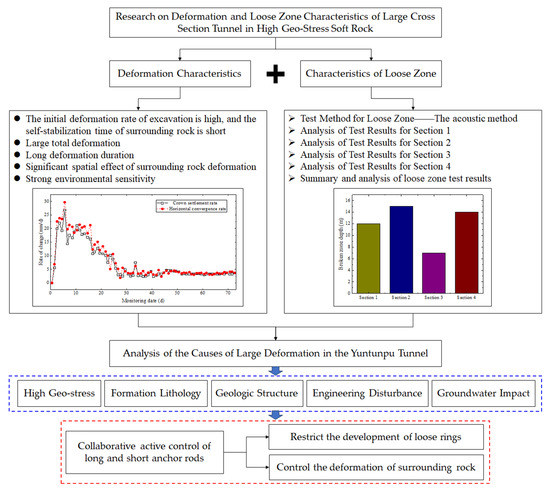
Figure 1.
Specific road map of the article.
2. Project Overview
The Yuntunpu Extra Long Tunnel of the Chengdu Lanzhou Railway is located between Minjiang Township and Qingyun Township in Songpan County, connecting to the Minjiang Village Extra Large Bridge at the front and Songpan Station at the back. The geological conditions of this section are complex, with unfavorable geological development. The total length of the tunnel is about 22.92 km, and it is a double-line joint repair tunnel with a maximum burial depth of about 780 m and a minimum burial depth of about 12 m. The tunnel site area is located in the rapidly changing terrain zone on the eastern side of the Sichuan Basin and the Qinghai Tibet Plateau, with complex geological conditions. The geologic structure presents an “A”-shaped triangular fault block, composed of the N.E. trending Longmenshan fault zone, the NWW near E.W. trending West Qinling fold zone protruding towards S, and the near S.N. trending Minjiang fault zone. Yuntunpu Tunnel mainly passes through sandstone intercalated with slate, carbonaceous phyllite, and phyllite intercalated with sandstone. The physical and mechanical parameters of the surrounding rock are shown in Table 1. Due to the strong compression of the fault block, the rock mass undergoes severe wrinkling deformation and fragmentation. Some sections of the tunnel pass through the core of multiple folds, and the self-stability ability of the surrounding rock is extremely poor [22]. The Yuntunpu Tunnel geological longitudinal section and the regional geologic structure map are shown in Figure 2 and Figure 3.

Table 1.
Physical and mechanical parameters of surrounding rock.
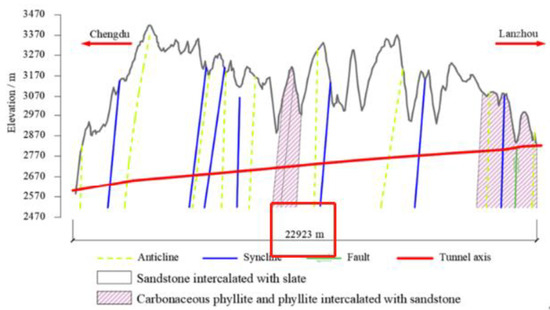
Figure 2.
Tunnel geological longitudinal section.
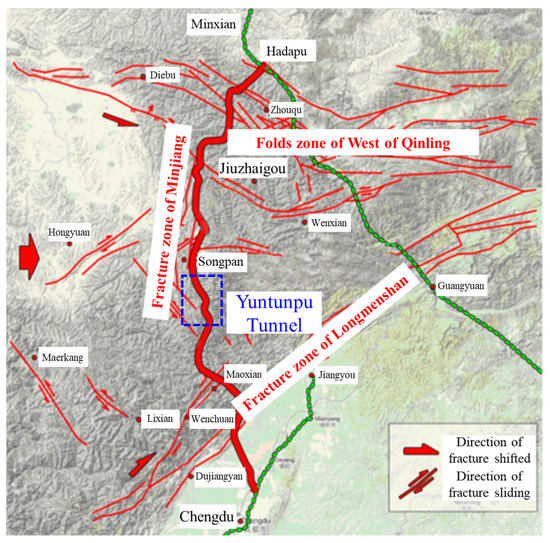
Figure 3.
Regional geological structure map of Yuntunpu Tunnel.
The Yuntunpu Tunnel has high geo-stress. The test was carried out at 8 m left of D6K228 + 085 by hydraulic fracturing method, and the final hole depth was 456.83 m. According to the integrity of the drilling core, ten testing sections were conducted within the depth of 270.00–450.00 m in hole PDZ Yuntunpu 04, and 7 effective data sections were successfully obtained. The stress measurement results are shown in Table 2. Pb is the fracturing pressure, Pr is the fracturing open pressure, Ps is the instantaneous closing pressure, PH is the hydrostatic pressure, P0 is the rock pore pressure, T is the rock tensile strength, SH is the maximum principal stress, Sh is the minimum principal stress, and Sv is the vertical stress.

Table 2.
PDZ-Yuntunpu-04 hydraulic fracturing in situ stress measurement results.
It can be found that the maximum horizontal principal stress near the tunnel body is about 15 MPa, and the minimum horizontal principal stress is about 10 MPa. The estimated vertical principal stress using the unit weight of the overlying rock layer is about 2.70 g/cm3, which is about 12 MPa. The relationship between the three-dimensional main stress values near the tunnel body is SH > Sv > Sh. The average ratio of the SH to Sv is 1.34, with a maximum of 1.40, indicating that the characteristics of in situ stress are mainly characterized by regional tectonic stress. The in situ tensile strength of rocks is 3.0–9.50 MPa. The rock structure and rock structure influence the testing section, and individual differences exist in individual testing sections, resulting in certain differences in testing results. The in situ fracture pressure of rocks is 14.0–19.0 MPa. The SH direction is N31° W–N52° W, with an average of N41° W. The angle between the SH direction and the tunnel axis is relatively large, which can easily cause significant deformation of the surrounding rock.
3. Deformation Characteristics of Yuntunpu Tunnel
With the excavation of multiple sections of the Yuntunpu Tunnel, the deformation of the surrounding rock continues to increase, with the most severe deformation reaching 50 cm/d. The damage to the support structure caused by large deformation includes the distortion and deformation of the steel arch frame, cracking, peeling, and local peeling of the lining concrete at the arch crown and side walls, seriously affecting construction safety and efficiency. The on-site monitoring data and construction records of the research section are summarized, and the major deformation characteristics of the severely deformed area are analyzed. They are mainly manifested in the following aspects:
- (1)
- The initial deformation rate of excavation is high, and the self-stabilization time of surrounding rock is short.
The deformation rate of the surrounding rock at section D6K234 + 205 is shown in Figure 4. From Figure 4, the rate of change of the arch settlement and horizontal convergence shows a trend of the first surge and then a slight decrease. The change rates of arch settlement and horizontal convergence peaked on the seventh day, and the maximum deformation change rates reached 27.3 mm/d and 30.7 mm/d, respectively. On the 28th day, the deformation rate decreased to the lowest and remained stable at around 5 mm/d. The initial deformation rate of the surrounding rock is high, and the deformation increases rapidly, making it difficult to control. The main reason is that the surrounding rock is weak, the crustal stress is high, and the deformation process is accompanied by strain softening. The self-stability ability of the surrounding rock is extremely poor, and the self-stability time is only ten hours at most.

Figure 4.
The curve of the deformation rate of surrounding rock (D6K234 + 205).
- (2)
- Large total deformation
The deformation of the Yuntunpu Tunnel is mainly caused by inward extrusion deformation, with significant deformation occurring at mileage 7#, mileage 6#, and mileage 5#. The deformation time history curve of section D6K234 + 210 surrounding rock is shown in Figure 5. It can be seen from Figure 5 that the deformation monitoring time of surrounding rock at this section is 101 days in total, and the initial deformation of the surrounding rock is large. The vault settlement and horizontal convergence reach 543.1 mm and 501.5 mm on the 20th day. The deformation growth slows, and the final cumulative monitoring deformation reaches 815.2 mm and 874.0 mm, respectively. The monitoring of the arch settlement and horizontal convergence values are close to 1 m, indicating that the deformation of the surrounding rock is uniform and the overall deformation is large.
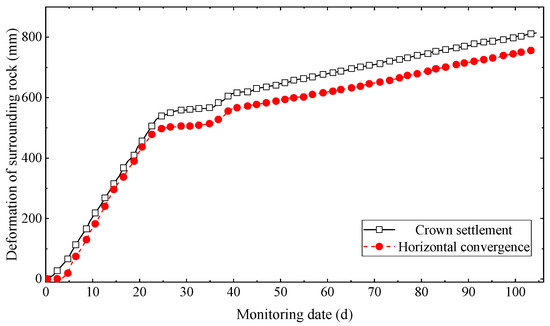
Figure 5.
Deformation duration of surrounding rock (D6K234 + 210).
- (3)
- Long deformation duration
The deformation time history curve of the surrounding rock of section D5K231 + 990 is shown in Figure 6. From Figure 6, the settlement and horizontal convergence of the arch crown in this section have a long time, which continues to increase after 60 days. After 120 days, the deformation reaches stability. Due to strain and water softening, the deformation is still increasing, with a maximum duration of 1 year. The results show that soft surrounding rock has serious rheology and long deformation duration under high geo-stress. Effective support measures should be taken as soon as possible to maintain the stability of the surrounding rock and provide a safe working space for construction and lining.
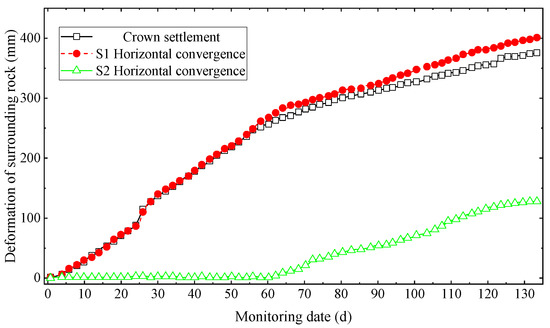
Figure 6.
Deformation curve of surrounding rock (D5K231 + 990).
- (4)
- Significant spatial effect of surrounding rock deformation
When the tunnel passes through the soft stratum with high geo-stress, the difficulty of the surrounding rock deformation and stability control increases with burial depth. Even if the strength of the surrounding rock increases and the burial depth increases, the surrounding rock is weak, and the deformation is still difficult to control, causing significant damage. In addition, the spatial effect of deformation in the Yuntunpu Tunnel is significant, with significantly uneven spatial distribution. Large deformations often occur in areas with tectonic and groundwater development.
- (5)
- Strong environmental sensitivity
The deformation of the surrounding rock of the Yuntunpu Tunnel is influenced by certain environmental factors, which are sensitive to groundwater erosion, blasting vibration, support failure, and other secondary disturbances caused by other actions and can promote the accelerated deformation of the surrounding rock.
4. Characteristics of Loose Zone in Yuntunpu Tunnel
The circular range where stress redistribution during tunnel excavation and construction disturbances causes the surrounding rock to rupture is called the loose zone [23,24]. The determination of the scope of the loose zone is of great significance for the effective and reasonable design of support, control of surrounding rock deformation, and related theoretical development.
4.1. Test Method for Loose Zone
Currently, the methods for determining the loose zone of surrounding rock include acoustic waves, seismic waves, etc. Among them, the acoustic method has the highest frequency of application due to its simple operation and good economy. The sound wave method obtains the physical and mechanical indicators of different rock and soil media based on the changes in propagation parameters (wave velocity, attenuation velocity, sound-time value, frequency spectrum, etc.) of sound waves in different rock and soil media [25,26]. Previous studies have shown that the scope of the loose zone varies with the geologic structure and physical and mechanical properties of the rock mass, the location and section shape of the tunnel, and the construction method. Therefore, based on the development density of sound waves in different fractures, different degrees of fragmentation, and changes in wave velocity and amplitude under stress conditions, the curve of wave velocity changing with depth is plotted, and the range of the tunnel’s loose zone is inferred by combining engineering geological data [27].
4.2. Analysis of Loose Zone Test Results
Four test sections were selected for the typical weak surrounding large rock deformation section of the Yuntunpu Tunnel test section (Section 1: D6K234 + 309, Section 2: D5K231 + 948, Section 3: D5K226 + 824.4, Section 4: D5K226 + 824.4). Each section is arranged with a measuring point on the left and right side walls, with a drilling depth of 20 m and an aperture of 100 mm. Due to construction site conditions, only one measuring point is arranged on the left side wall of the tunnel for Section 3. The test results are shown in Figure 7, Figure 8, Figure 9, Figure 10, Figure 11, Figure 12 and Figure 13. In the figure, L represents the drilling depth, and Vp represents the elastic longitudinal wave velocity of the surrounding rock.
- (1)
- Analysis of Test Results for Section 1
The test results of Section 1 are shown in Figure 7 and Figure 8. The construction method of this experimental section adopts two-step excavation. According to the variation of surrounding rock wave velocity with drilling depth, it can be found that the 7# small mileage direction face has severe water inrush due to the right drilling hole. Therefore, the left side wall is mainly used as the main reference value for analyzing data. The wave velocity of the surrounding rock on the left side wall undergoes a drastic change of around 12 m. Based on the proposed criteria for evaluating the loose zone of the surrounding rock, it is comprehensively determined that the range of the loose zone is around 12 m.
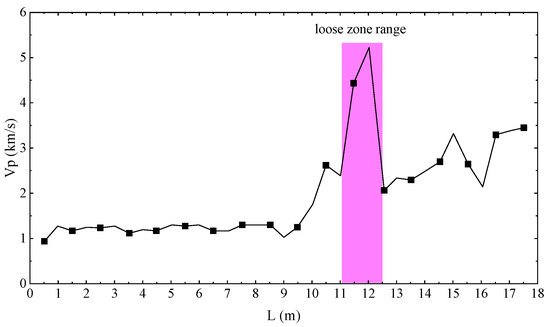
Figure 7.
Variation of wave velocity of surrounding rock of left wall-drilling depth (D6K234 + 309).
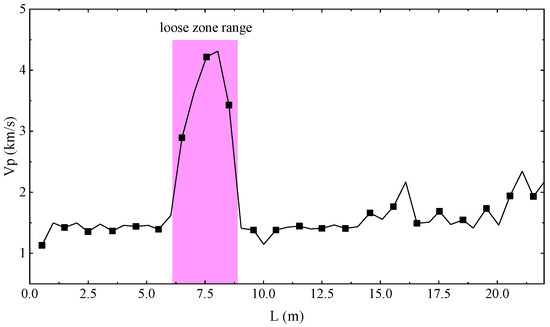
Figure 8.
Variation of wave velocity of surrounding rock of right wall-drilling depth (D6K234 + 309).
- (2)
- Analysis of Test Results for Section 2
The test results of Section 2 are shown in Figure 9 and Figure 10. According to the variation of the surrounding rock wave velocity with drilling depth, it can be found that the 6# large mileage direction tunnel face is mainly based on the right side wall as the main reference value for analyzing data due to severe hole collapse and blockage on the left side of the drilling hole, as well as high water output. The wave velocity of the surrounding rock on the right side wall undergoes a drastic change of around 15 m. According to the proposed evaluation criteria for the loose zone of the surrounding rock, the loose zone range is roughly 15 m.
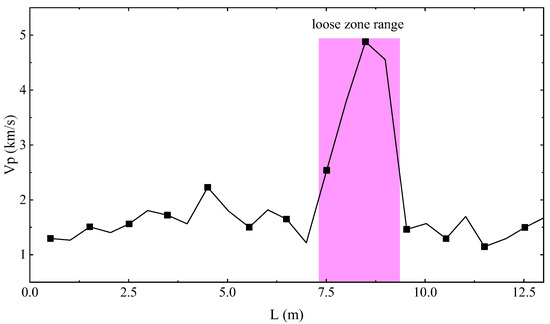
Figure 9.
Variation of wave velocity of surrounding rock of left wall-drilling depth (D5K231 + 948).

Figure 10.
Variation of wave velocity of surrounding rock of right wall-drilling depth (D5K231 + 948).
- (3)
- Analysis of Test Results for Section 3
The test results of Section 3 are shown in Figure 11. According to the variation of the surrounding rock wave velocity with drilling depth, it can be observed that the wave velocity of the surrounding rock measured on the left side wall of the 5# large mileage direction face changes sharply around 7 m. According to the proposed evaluation criteria for the broken rock zone, the loose rock zone range is approximately 7 m.
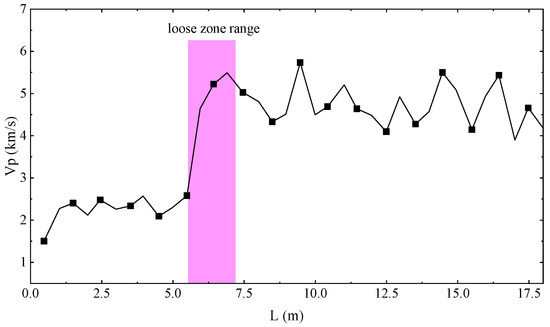
Figure 11.
Variation of wave velocity of surrounding rock of right wall-drilling depth (D5K226 + 824.4).
- (4)
- Analysis of Test Results for Section 4
The test results of Section 4 are shown in Figure 12 and Figure 13. According to the variation of surrounding rock wave velocity with drilling depth, it can be found that the testing process of the drilling hole set in the direction of 5# small mileage is relatively smooth. Based on the comprehensive comparison of the wave velocity variation characteristics of the surrounding rock on both sides of the side walls and the proposed evaluation criteria for the broken rock zone, the range of the loose rock zone caused by tunnel excavation is approximately 14 m.

Figure 12.
Variation of wave velocity of surrounding rock of left wall-drilling depth (D5K225 + 620).
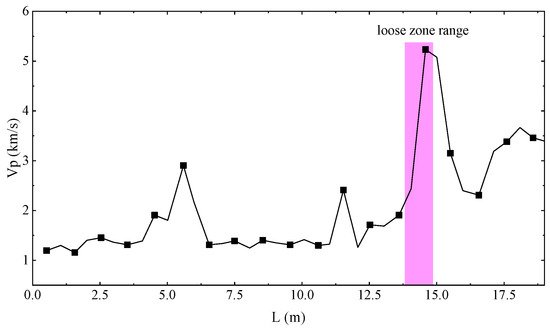
Figure 13.
Variation of wave velocity of surrounding rock of right wall-drilling depth (D5K225 + 620).
- (5)
- Summary and analysis of loose zone test results
The summary of the loose zone test results is shown in Figure 14. From Figure 14, it can be seen that the loose zone of the Yuntunpu Tunnel ranges from 12 to 14 m. Affected by the grade and structure of the surrounding rock, the wave velocity variation characteristics exhibited by different grades of surrounding rock vary greatly. The wave velocity increases and decreases with increasing drilling depth for weak rock masses. For harder rock masses, the wave velocity shows a trend of first improving and then stabilizing with increasing drilling depth. The difference in the trend of changes between soft rock and hard rock is mainly due to the significant impact of stress concentration caused by soft rock tunnel excavation on the wave velocity of the rock mass.
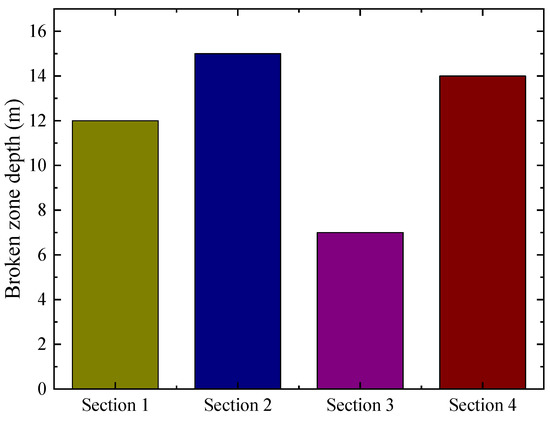
Figure 14.
Summary of loose zone test of Yuntunpu Tunnel.
The tunnel has a wide range of loose zones, and severe large deformation problems occurred during construction. Therefore, to prevent the development of loose zones, it is necessary to implement a collaborative approach of long and short anchor rods to actively control the development of the loose zones and the deformation of the surrounding rock. After excavating the upper bench, short anchor bolts should be promptly applied and prestressed to form a “bearing ring” in the shallow surrounding rock. After excavation of the middle and lower steps, short prestressed anchor rods and long anchor rods shall be applied, and the long anchor rods shall pass through the range of the loosening zones to further strengthen the “bearing ring” and transfer some of the surrounding rock stress to the outside of the loosening zones. The ultimate goal is to limit the loose zones’ further development and control the surrounding rock’s deformation.
5. Analysis of the Causes of Large Deformation in the Yuntunpu Tunnel
5.1. High Geo-Stress
The initial crustal stress value is the decisive factor affecting the deformation of the tunnel’s surrounding rock [11]. After the tunnel excavation, the crustal stress can be released, and the surrounding rock will deform. According to the field measurement data, the rock core cracked into cakes under high geo-stress, and the uneven horizontal stress distribution resulted in the uneven thickness of the rock cakes. Before the tunnel excavation, the surrounding rock is in the post-peak plastic failure state. After the tunnel excavation, the original crustal stress equilibrium state is broken, and the stress is redistributed. In addition, the surrounding rock is weak, and the self-stability of the surrounding rock is poor, resulting in a large range of inward extrusion deformation and failure of the surrounding rock.
5.2. Formation Lithology
The formation lithology is an important factor affecting the deformation of the surrounding rock [28]. The soft rock of the Yuntunpu Tunnel is mainly a low-grade metamorphic rock with a phyletic structure. It is softened and marginalized seriously when encountering water. Joint fissures are developed. The uniaxial compressive strength of the rock is less than 30 MPa. Moreover, the engineering properties are poor, which can easily cause large deformation of the surrounding rock and have poor resistance to weathering. After excavation, it is easy to produce rock debris and debris, and powdering can occur even if it is not affected by water.
5.3. Geologic Structure
The site area of the Yuntunpu Tunnel is located in multiple fracture zones with complex and diverse geological structures [13]. The tunnel site mainly passes through the “A”-shaped fault block composed of Longmenshan Fracture, West Qinling fold, and Minjiang Fracture zones. In addition, strong geological tectonic processes promote the development of structural planes such as rock joints, fractures, unconformity surfaces, and contact surfaces of intrusive bodies, decreasing rock strength. Affected by high geo-stress, blasting vibration, and tunnel construction, the self-stability ability of the surrounding rock decreases, resulting in shear and sliding of the structural plane, leading to major deformation disasters and severe damage to the initial support.
5.4. Engineering Disturbance
Engineering disturbance directly affects the deformation of the surrounding rock [29]. Before the tunnel excavation, the rock mass is in equilibrium, and the rock mass is subject to high initial crustal stress in three-dimensional space. With the tunnel excavation, the rock surface around the tunnel is in an unconstrained free state, the original crustal stress balance is broken, and the stress is redistributed. The surrounding rock absorbs part of the crustal stress, and the transfer value is deep in the surrounding rock. The other part is released in the form of deformation energy. The surrounding rock undergoes extrusion deformation towards the tunnel clearance, leading to local stress concentration and a new equilibrium state during stress release and transfer. According to the elastic and elastic–plastic theory analysis, crustal stress changes from three to two directions. The shear stress increases, and the radial stress decreases. When the limit value is reached, the surrounding rock is within the range of compressive stress. The tunnel excavation’s unloading effect and deformation cause the rock skeleton’s matrix to expand due to sliding and opening, resulting in shear plastic deformation. The modulus of the surrounding rock strength decreases, and the rock mass’s shear creep further increases the surrounding rock’s deformation.
5.5. Groundwater Impact
Groundwater is an indirect effect that affects tunnel-surrounded rock deformation [30]. The lithology of the Yuntunpu Tunnel is mainly the phyllite stratum, in which sericite, chlorite, and other minerals are dissolved by water absorption and are highly sensitive to water. It is easy to be softened, disintegrated, and argillized under pressure when encountering water, leading to a deterioration of cohesion and internal friction angle. At the same time, the primary structure in the phyllite collapses, resulting in a rapid decrease in mechanical properties. Under high geo-stress, the water in phyllite is squeezed out, and the water content decreases greatly. After tunnel excavation, the dry soft rock provides a deep water path for groundwater collection, leading to water leakage within the tunnel and further increasing the deformation of the surrounding rock.
6. Conclusions
This article relies on the Yuntunpu Tunnel Project to study the characteristics of a large deformation in the tunnel and tests the loose zone of the tunnel. Finally, the reasons for the large deformation in the tunnel are analyzed, and the main conclusions are as follows:
- (1)
- The large deformation of the Yuntunpu Tunnel is characterized by a large deformation rate of the surrounding rock, short self-stabilization time of the surrounding rock, large cumulative deformation, and long deformation duration.
- (2)
- The range of tunnel loosening zones is 12–14 m. Affected by the grade and structure of the surrounding rock, the wave velocity variation characteristics exhibited by different grades of surrounding rock vary greatly.
- (3)
- It is recommended to use long and short anchor rods and to actively limit the scope of the loosening zones and control the deformation of the surrounding rock in collaboration with short prestressed anchor rods and long anchor rods.
- (4)
- High geo-stress and geological lithology are the decisive and important factors for the occurrence of large deformation disasters in the tunnel, and the reasons for the large deformation of the tunnel also include geological structures, engineering disturbances, and the influence of groundwater.
This article discusses in detail the characteristics of large deformations, the characteristics of loose zones, and the causes of large deformations in the Yuntunpu Tunnel. The next step will be to explore the application effects of different control measures in the Yuntunpu Tunnel project based on its characteristics and conduct in-depth research on each measure to optimize its construction parameters.
Author Contributions
Conceptualization, D.M. and Z.T.; methodology, D.M.; validation, L.B., Z.T. and B.Z.; formal analysis, J.Z.; investigation, B.Z.; data curation, B.Z.; writing—original draft preparation, B.Z. and J.Z.; writing—review and editing, Z.T.; visualization, D.M.; supervision, Z.T.; project administration, D.M.; funding acquisition, Z.T. All authors have read and agreed to the published version of the manuscript.
Funding
This research was funded by the National Natural Science Foundation of China, grant number 51978041.
Institutional Review Board Statement
The participant’s personal identification information in the study did not include personal information. Ethical review and approval were not required for the study.
Informed Consent Statement
Not applicable.
Data Availability Statement
Data sharing is not applicable.
Conflicts of Interest
The authors declare no conflict of interest.
References
- Zhao, C.; Lei, M.; Jia, C.; Zheng, K.; Song, Y.; Shi, Y. Asymmetric Large Deformation of Tunnel Induced by Groundwater in Carbonaceous Shale. Bull. Eng. Geol. Environ. 2022, 81, 260. [Google Scholar] [CrossRef]
- Deng, H.S.; Fu, H.L.; Shi, Y.; Zhao, Y.Y.; Hou, W.Z. Countermeasures against large deformation of deep-buried soft rock tunnels in areas with high geostress: A case study—ScienceDirect. Tunn. Undergr. Space Technol. 2022, 119, 104238. [Google Scholar] [CrossRef]
- Cui, G.; Qi, J.; Wang, D. Research on Large Deformation Control Technology of Tunnels in Squeezing Rock and Its Application. Sci. Prog. 2020, 103, 003685042092316. [Google Scholar] [CrossRef] [PubMed]
- He, M.; Sui, Q.; Li, M.; Wang, Z.; Tao, Z. Compensation excavation method control for large deformation disaster of mountain soft rock tunnel. Int. J. Min. Sci. Technol. 2022, 32, 951–963. [Google Scholar] [CrossRef]
- Wang, R.; Liu, Y.; Deng, X.; Zhang, Y.; Huang, X.; Ding, X. Analysis on Loose Circle of Surrounding Rock of Large Deformation Soft-rock Tunnel. Adv. Civ. Eng. 2020, 2020, 8842976. [Google Scholar] [CrossRef]
- Fan, J.; Guo, Z.; Qiao, X.; Tao, Z.; Wang, F.; Zhang, C. Constant Resistance and Yielding Support Technology for Large Deformations of Surrounding Rocks in the Minxian Tunnel. Adv. Civ. Eng. 2020, 2020, 8850686. [Google Scholar] [CrossRef]
- Zhang, B.; Sun, X.; Yang, K.; Guo, P.; Tao, Z. Model Test Study on Large Deformation Mechanism of Thin-bedded Metamorphic Sandstone Tunnel. Bull. Eng. Geol. Environ. 2022, 81, 436. [Google Scholar] [CrossRef]
- Bian, K.; Liu, J.; Liu, Z.; Liu, S.; Ai, F.; Zheng, X.; Ni, S.; Zhang, W. Mechanisms of Large Deformation in Soft Rock Tunnels: A Case Study of Huangjiazhai Tunnel. Bull. Eng. Geol. Environ. 2019, 78, 431–444. [Google Scholar] [CrossRef]
- Wang, F.N.; Guo, Z.B.; Qiao, X.B.; Fan, J.Y.; Li, W.; Mi, M.; He, M.C. Large deformation mechanism of thin-layered carbonaceous slate and energy coupling support technology of NPR anchor cable in Minxian Tunnel: A case study. Tunn. Undergr. Space Technol. 2021, 117, 104151. [Google Scholar] [CrossRef]
- Liu, W.; Chen, J.; Chen, L.; Luo, Y.; Shi, Z.; Wu, Y. Nonlinear deformation behaviors and a new approach for the classification and prediction of large deformation in tunnel construction stage: A case study. Eur. J. Environ. Civ. Eng. 2022, 26, 2008–2036. [Google Scholar] [CrossRef]
- Wu, F.; Miao, J.; Bao, H.; Wu, J. Large deformation of tunnel in slate-schistose rock: A case study on Muzhailing tunnel, Lan-Yu railway, China. Eng. Geol. Soc. Territ. 2015, 6, 17–23. [Google Scholar]
- Yang, J. Study on Large Deformation Prediction and Control Technology of Carbonaceous Slate Tunnel in Lixiang Railway. Geofluids 2022, 2022, 7236065. [Google Scholar] [CrossRef]
- Li, J.Q.; Wang, Z.F.; Wang, Y.Q.; Chang, H.T. Analysis and countermeasures of large deformation of deep-buried tunnel excavated in layered rock strata: A case study. Eng. Fail. Anal. 2023, 146, 107057. [Google Scholar] [CrossRef]
- Wu, Y.; Zhou, Z.; Shao, S.; Zhao, Z.; Hu, K.; Wang, S. Monitoring and Analysis of Deformation Refinement Characteristics of a Loess Tunnel Based on 3D Laser Scanning Technology. Appl. Sci. 2022, 12, 5136. [Google Scholar] [CrossRef]
- Cao, P.; Hu, X.; Liu, E.; Guo, H. Mechanical properties and numerical simulation analysis on large deformation of Jiangluling Carbonaceous Shale Tunnel. Front. Earth Sci. 2023, 11, 1125410. [Google Scholar] [CrossRef]
- Tan, Z.; Li, S.; Yang, Y.; Wang, J. Large deformation characteristics and controlling measures of steeply inclined and layered soft rock of tunnels in plate suture zones. Eng. Fail. Anal. 2022, 131, 105831. [Google Scholar] [CrossRef]
- Liu, Q.; Zhi, C.; Yan, T. Numerical Study on Comparison and Selection of Water Tunnel Section Types. IOP Conf. Ser. Earth Environ. Sci. 2022, 455, 012161. [Google Scholar] [CrossRef]
- Wu, P.; Fang, Z.; Wang, X.; Zhu, G. Reliability Evaluation and Prediction of Deep Buried Tunnel Based on Similarity Theory and Model Test. KSCE J. Civ. Eng. 2023, 27, 2654–2665. [Google Scholar] [CrossRef]
- Hu, Q.Z.; Zhang, R.; Gao, Y.; Hong, C.W. Study on the response mechanism of tunnel blasting dynamics and the spatial variation characteristics of the surrounding rock. IOP Conf. Ser. Earth Environ. Sci. 2020, 510, 052067. [Google Scholar] [CrossRef]
- Zhao, J.; Tan, Z.; Li, Q.; Li, L. Characteristics and mechanism of large deformation of squeezing tunnel in phyllite stratum. Can. Geotech. J. 2023, ja. [Google Scholar] [CrossRef]
- Zhao, J.P.; Tan, Z.S.; Li, L.; Wang, X.Y. Supporting structure failure caused by the squeezing tunnel creep and its reinforcement measure. J. Mt. Sci. 2023, 20, 1774–1789. [Google Scholar] [CrossRef]
- Ding, Y.; Zhang, X.; Zhang, B. Preliminary Study on Double Lining Support Design for Water Plugging of Highway Tunnel Under High Water Pressure in Mountain Area Based on Limited Drainage. Appl. Sci. 2022, 12, 7905. [Google Scholar] [CrossRef]
- Lei, G.; Wang, G.; Luo, J.; Hua, F.; Gong, X. Theoretical Study of Surrounding Rock Loose Zone Scope Based on Stress Transfer and Work–energy Relationship Theory. Appl. Sci. 2022, 12, 7292. [Google Scholar] [CrossRef]
- Wang, Y.S.; Wu, Z.Q.; Li, M.H.; Yang, Q.X. The Field Ultrasonic Test of the Disturbance of Surrounding Rock by the TBM Construction. Adv. Mater. Res. 2012, 446, 2101–2104. [Google Scholar] [CrossRef]
- Jiao, P.; Li, S.; Li, X. On-siteTest Study on DefiningLoose Range of Surrounding Rock of High-way Tunnel with Multi-measuring Method. In Proceedings of the 2016 International Conference on Civil, Transportation and Environment, Guangzhou, China, 30–31 January 2016; Atlantis Press: Paris, France, 2016; pp. 11–14. [Google Scholar]
- Cui, F.Z.; Xue, H.J.; He, T.Y.; Li, T.T.; Zuo, J.J.; Guan, X. Research on Loose Circle Test of Deep Broken Roadway. Appl. Mech. Mater. 2014, 638, 904–907. [Google Scholar] [CrossRef]
- Li, F.W.; Jin, L.Z.; Han, H.R.; Zhang, X.C. Structural Analysis and Study on Support Technology of Refuge Chamber of Mine. Appl. Mech. Mater. 2012, 204, 1356–1361. [Google Scholar] [CrossRef]
- Lei, M.; Liu, J.; Lin, Y.; Shi, C.; Liu, C. Deformation Characteristics and Influence Factors of a Shallow Tunnel Excavated in Soft Clay with High Plasticity. Adv. Civ. Eng. 2019, 2019, 7483628. [Google Scholar] [CrossRef]
- Zhou, Z.; Ding, H.; Miao, L.; Gong, C. Predictive model for the surface settlement caused by the excavation of twin tunnels. Tunn. Undergr. Space Technol. 2021, 114, 104014. [Google Scholar] [CrossRef]
- Hu, K.; Xu, P.; Wu, Y.; Zhao, Z.; Wang, S. Analysis of Causes for Large Deformation of Rich Water Tunnel in Loess and Countermeasures: A Case Study. In Proceedings of the CICTP; ASCE: Reston, VA, USA, 2021; pp. 852–862. [Google Scholar]
Disclaimer/Publisher’s Note: The statements, opinions and data contained in all publications are solely those of the individual author(s) and contributor(s) and not of MDPI and/or the editor(s). MDPI and/or the editor(s) disclaim responsibility for any injury to people or property resulting from any ideas, methods, instructions or products referred to in the content. |
© 2023 by the authors. Licensee MDPI, Basel, Switzerland. This article is an open access article distributed under the terms and conditions of the Creative Commons Attribution (CC BY) license (https://creativecommons.org/licenses/by/4.0/).